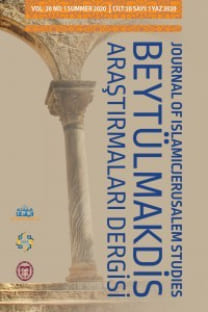Haçlı Seferleri Esnasında Bilâdü'ş-Şâm'da Birlik Kurulmasında Nureddin Mahmud'un Rolü
The Role of Nur al-Din Zengi in unifying Bilad al-Sham during the Crusades
The Crusades were one of the most dangerous and the infamous wars led by European countries against the Muslim world and in particular Bilad al-Sham, as it left great effects on subsequent events in the Muslim and western worlds. It is well-known that these wars took its name from the cross which became a motto for these wars. A number of reasons helped in the making of the crusade amongst them: the conditions that prevailed in Europe, the historical context, reasons concerned with Christianity, the Battle of Manzikert and the call of Emperor Alexius Comnenus, the Byzantine Emperor, to the Pope Gregory VII to assist the Christians of the East. In response to the crusade some Muslim leaders made an effort to counter them and try to defend Muslim lands and force the crusaders out. Thus, the family Zengi emerged to carry out this task in defending the Muslim world and its holy land and sites. Prior to defending the land from this foreign invasion and occupation, strenuous efforts were essential to unify the Muslim states in order to achieve this task. Therefore, this paper studies the efforts of Nur al-Din Mahmoud in unify Bilad al-Sham during the Crusades. The importance of the study is reflected in shedding light on this crucial historical period and tries to show the efforts that was made during the Crusades to find a united Islamic front to counter the crusade. The study’s main objectives are aimed at seeing what prepared Nur al-Din to take on this great task from his background and biography. Also, the extent of his role in unifying Bilad al-Sham during the period of the crusades in preparation to face them and end their occupation of Muslim lands.
Keywords:
Nur al-Din, Crusaders, Damascus, Mosul, Latin Kingdom of Jerusalem, Unity,
___
- المصادر والمراجع :1. أبو زهرة ، محمد ، تاريخ المذاهب الإسلامية ، دار الفكر ، القاهرة ، بدون تاريخ ، ص 20 . 2. أبو شامة ، الروضتين في أخبار الدولتين النورية والصلاحية ، دار الجيل ، بيروت ، ج1، بدون تاريخ ، ص103 .3. ابن الأثير ، عز الدين أبي الحسن علي بن أبي الكرم محمد بن عبد الكريم بن عبد الواحد الشيباني ، الكامل في التاريخ ، دار الفكر ، بيروت ، 1978م ،ج10 ، ص 234 .4. الأعظمي ، علي ظريف عبد المجيد، مؤجز تاريخ بغداد القديم والحديث ، بغداد ، 1929م ، ص 45 .5. الحموي ، ياقوت ، شهاب الدين أبو عبد الله ، معجم البلدان ، دار صادر بيروت ، 1977م ، ج2 ، ص 205 . 6. الحويرى ، محمود محمد ، بناء الجبهة الإسلامية المتحدة ، دار المعارف ، الطبعة الأولي ، 1992م ، ص 94 . 7. السيوطي ، جلال الدين ، عبد الرحمن ، تاريخ الخلفاء ، تحقيق محمد أبو الفضل إبراهيم ، دار الفكر الغربي ، بدون تاريخ ، ص 298 .8. الصلابي ، علي محمد ، نور الدين محمود شخصيته وعصره ، مؤسسة أقرا ، الطبعة الأولي ، 2007م ، ص 551 .9. المطوي ، محمد العرويسي ، الحروب الصليبية في المشرق والمغرب ، دار الغرب الإسلامي ، مكان الطبع مجهول ،1982م ، ص 22 . 10. بيطار ، أمينة ، تاريخ العصر الأيوبي ، دار الفكر العربي ، القاهرة ، بدون تاريخ ، ص 66 -67. 11. جمال الدين محمد بن علي الأصفهاني ، ولد في أصفهان وقدم إلى بغداد ثم الشام حيث اتصل بنور الدين محمود 12. حسن ، حسن إبراهيم ، تاريخ الدولة الفاطمية في المغرب ومصر وسورية وبلاد العرب ، مكتبة النهضة المصرية ، القاهرة ، الطبعة الثالثة ، 1964م ، ص 233 . 13. حسنين ، عبد المنعم ، سلاجقة إيران والعراق ، مكتبة النهضة المصرية ،1959م ، ص 55 . 14. طقوش ، محمد سهيل ، حروب الفرنجة في المشرق ، دار النفائس ، الطبعة الأولي ،2011م ، ص 304 . 15. عاشور ، فأيد حماد محمد ، جهاد المسلمين في الحروب الصليبية (العصر الفاطمي _السلجوقي_ الزنكي ) ، مؤسسة الرسالة ، بيروت ، الطبعة الأولى ، 1981م ، ص206 .16. عوض، محمد مؤنس أحمد ، السياسة الخارجية للدولة النورية ، عين للدراسات والبحوث الإنسانية والاجتماعية ، مكان الطبع مجهول ، 1998، ص11- 12 .
- ISSN: 1367-1936
- Yayın Aralığı: Yılda 2 Sayı
- Başlangıç: 1997
- Yayıncı: Beytülmakdis Çalışmaları Vakfı
Sayıdaki Diğer Makaleler
MARDİN MÜZESİ’NDEKİ NUREDDİN ZENGİ SİKKELERİ
NÛREDDİN MAHMUD ZENGİ’NİN KUZEY SINIRINDAKİ HIRİSTİYAN DEVLETLERLE İLİŞKİLERİ (1146-1174)
ORTAÇAĞ’DA İSLÂM/TÜRK-İSLÂM TIBBININ PARLAK BİR MÜMESSİLİ: NUREDDİN HASTANESİ
Haçlı Seferleri Esnasında Bilâdü'ş-Şâm'da Birlik Kurulmasında Nureddin Mahmud'un Rolü
Ahmed Abdallah MUHAMMAD, Mukhtar Ramadan AL-FAKI
Nureddin Mahmud b. İmadüddin Zengi Döneminde Vakıflar
Burhan CHE DAUD, Abdal-fattah EL-AWAİSİ, Mohd Roslan Mohd NOR
NÛREDDÎN ZENGÎ'NİN, SALÂHADDÎN EYYÛBÎ ELİYLE GERÇEKLEŞEN HAYALLERİ
NÛREDDİN MAHMUD ZENGÎ DEVRİ’NDE (541-569/1146-1174) İLMİYE SINIFI
Nureddin Zengi'nin Dımaşk ve Menbiç'teki Askeri Faaliyetleri
